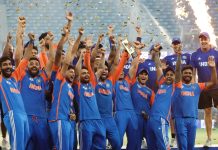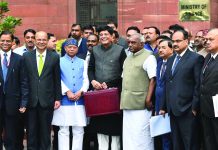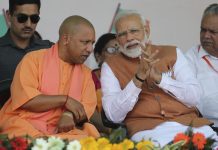
It is tough to read Lalit Modi’s mind. More importantly, it is almost impossible to decipher his motives and actions. Finally, it is a hopeless exercise to attempt to understand his personality. People judge him by what they wish to see. To describe his traits is futile. Like the blind men who portray an elephant in varying manner, he means different things to different people. The reason: Lalit Kumar Modi, who is at the epicentre of #LalitGate scandal that engulfed Sushma Swaraj, external affairs minister, Vasundhara Raje, Rajasthan chief minister, Arun Jaitley, finance minister, and NDA and UPA politicians, is a bundle of contradictions, and loves to ‘dance on any chance’.
His father, KK Modi, who lords over the nearly $3 billion business empire that comprises, among others, Godfrey Phillips and Indofil Industries, feels he is a brilliant, yet maverick and strong-headed individual who is bubbling with ideas. His enemies like N Srinivasan, chairman of International Cricket Council (ICC), think he is a conceited, ambitious and arrogant megalomaniac. His loyalists say he is charming, hard-working and brilliant. Those who don’t know him well contend he is corrupt to the core. He is all of the above – and more. You can hate LaMo or love him, but you cannot ignore him.
He loves a no-holds-barred battle, even if his friends get scarred in the process. He is a consummate deal-maker, who gets things done even if the rules need to be twisted a wee bit. He runs his businesses like a fiefdom, and hates any challenges to his powers. He thinks big, but fails to realise the future consequences. He is ambitious, over-confident and self-obsessed; LaMo feels that he knows best. He is a die-hard networker, who has the urge to know everyone who is someone.
Founder of ‘Fight Club’
Whether it was his career as a businessman or cricket administrator, LaMo never shied away from a fight. In fact, he doesn’t hold back any punches when he is in the midst of one. He wants to win at any cost; if he loses, he carries the grudge until he gets his revenge. In 1999, he ‘bribed’ his way into the Himachal Pradesh Cricket Association (HPCA). Raghubir Singh Thakur, former head of the association, admitted that LaMo donated 1,200,000 and got the HPCA membership.
Within a year, LaMo was thrown out after a tussle with Prem Kumar Dhumal, the then state chief minister, and his son, Anurag Thakur, who was the HPCA president in 2000. Later, LaMo took on Thakur, who is now secretary of Board of Control for Cricket in India (BCCI).In May 2015 after the Enforcement Directorate (ED) raided the offices of bookies, LaMo tweeted: “Again these jokers in @bcci @icc @ipl #indiacements @anuragthakur trying 2 hoodwink us all in regard to #illegal betting quantum.”
After his ouster from HPCA, he surreptitiously got into the Rajasthan Cricket Association (RCA), which was ruled by the Rungta family, which had 57 votes among the family members and loyalists, and enjoyed a clear majority given that the total votes were around 90. Given his cricket ambitions, LaMo decided to muscle out the Rungta family. Sources contend that he got his friend, Raje, who was then also the chief minister, to promulgate an ordinance in 2004.
The ordinance, Rajasthan Sports (Registration, Recognition & Regulation of Associations), asked all the state’s sports associations to disband and register afresh. In addition, it stated that individual members in any association would not be allowed to vote or stand for any post in any organisational elections. Suddenly, the Rungta family and its loyalists had no say in the RCA. Backed by Raje, LaMo gained support of the voting members and became the association’s president in 2005.
In the early 2000s, he clashed with Michel Adam, president, Fashion TV, whose channel was distributed in India by LaMo. The latter claimed that FTV had flouted the contract when it decrypted its signal and converted the channel into a free-to-air one. Adam had no confidence in LaMo’s strategy to make FTV a paid channel. FTV filed civil-criminal charges against LaMo in France and India in mid- 2003. As the two parties fought a legal battle, they settled out of court in May 2004.
Everyone knows about the ongoing, five-year-old and legendary war between LaMo and Srinivasan. Both claimed that the other had caused losses worth tens of thousands of crore to the BCCI. In recent times, after #LalitGate scandal, LaMo leaked emails on his twitter handle that hinted at Srinivasan’s guilt. In 2010, the BCCI issued three show-cause notices to LaMo to show how the IPL fish had rotted at the head. Both LaMo and Srinivasan have denied the charges.
Consummate deal-maker
Nothing can elaborate LaMo’s ability to finalise a seemingly-impossible deal than the manner in which he renegotiated IPL’s telecast rights with Sony four weeks before the beginning of IPL’s second season in 2009. LaMo wanted to rework the deal a year after it was inked because he was unhappy with Sony on issues like incorrect declaration of advertising time and dirty feed of the IPL matches. But when he could not reach a consensus with Sony “on language (of the reworked contract) and guarantees (to be paid by Sony),” he abruptly cancelled the contract on 14 March 2009.
BCCI sent the termination letter at 8.14 pm, and two hours later, at 10.15 pm, Sony replied that it would approach the Bombay High Court the next day at 11 am to seek an interim relief. LaMo knew that this would happen. Therefore, even before he cancelled the agreement, he initiated discussions with other potential broadcasters such as ESPN, STAR, NDTV and wsg India, which had won the original bid and outsourced the telecast within the subcontinent to Sony in 2008.
The idea behind the talks with other broadcasters was to convince the court that it couldn’t give relief to Sony as that would hamper BCCI’s ongoing moves to sell the rights to a new party. However, LaMo still felt that the best solution was to arrive at a consensus with Sony since he couldn’t be sure about the court’s decision. He had less than 13 hours — between 10.15 pm (14 March) when he got Sony’s email and 11 am (15 March) when it would approach the high court. The lawyers from the three sides – IPL, Sony and WSG India closeted themselves in a room.
A new deal was stuck within a few hours at 3 am. WSG India decided to buy back the rights for the subcontinent, but it asked the BCCI to sign the agreement with its sister concern, WSG Mauritius. The reason: if the judge was told that a new contract was inked with a global firm, he or she may find it tougher to grant a legal relief to Sony. LaMo was right; on March 16, the high court refused to extend the interim relief to Sony when LaMo produced the signed deal with wsg India and wsg Mauritius.
In a bid to keep a foot in the ‘telecast’ door, Sony asked the court to bar the BCCI from signing an agreement with any other broadcaster. The fact is that Sony knew that wsg Mauritius would need to outsource the telecast to a third party as wsg India had done in 2008. LaMo had preempted this too. On 15 March itself, wsg Mauritius was given a list of approved broadcasters to whom the former could quickly sell the telecast rights for the subcontinent. Therefore, the court refused to entertain Sony’s plea. The same day, 16 March, wsg Mauritius inked a draft deal with ndtv Mauritius.
Sony was forced to crawl back to the negotiating table. Within a few days, the broadcaster agreed to an out-of-court settlement with BCCI. It agreed to all the conditions imposed by LaMo. On March 25, the BCCI inked two separate ‘telecast’ contracts – one with Sony for IPL telecast within the subcontinent for nine years, and the other with WSG India for telecast in the rest of the world for the same period. IPL’s second season was just two weeks away.
Most importantly, the value of the telecast rights sold to Sony and WSG India in 2009 was worth over Rs 8,000 crore for nine years, a huge jump over the earlier figure of over 5,000 crore for ten years. This was exactly what LaMo wanted. After the successful first season of IPL, he realised that the value of the telecast rights had zoomed, and wanted Sony and WSG to pay a higher price. He succeeded.












